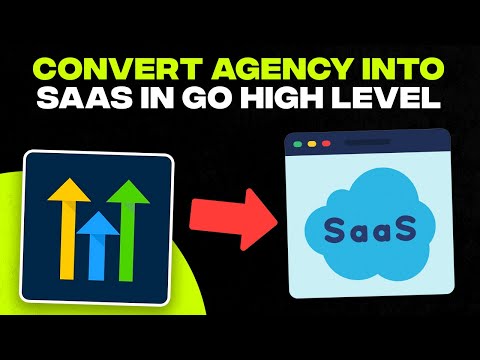
Agency owners might see a chance to move away from endless client work and try productizing their services. CreatorConcepts shares easy steps and real-world insights to help you shift focus, even if it feels a bit off at first. This change, while slightly unpredictable, can spur growth and build recurring revenue without losing your core focus.

The transition from a service-based agency model to a productised SaaS business represents more than just a technological upgrade—it’s a complete shift in mindset. Agency owners no longer need to be chained to client work. Instead, they can craft a scalable solution that generates stable, recurring revenue and unlocks untapped growth potential.
The evolution toward SaaS means moving away from one-off client projects and repositioning your expertise into a platform that serves multiple users simultaneously. This transformation does not only bring in predictable income but also allows agency owners to build intellectual property that can be refined and enhanced over time. Embracing SaaS can also lead to:
The SaaS model promotes scalability. Instead of increasing service charges per client, a subscription-based system lets you focus on streamlining processes while the product steadily grows. Ultimately, it is about achieving leverage, reducing burnout, and paving the way for long-term success.
Many agency owners now turn to no-code platforms like Bubble and Webflow to speed up product development. These tools have significantly lowered the barrier to entry, allowing even non-technical founders to build and iterate on a functional product quickly.
No-code platforms are designed to simplify design and development. Agencies can convert their service expertise into a SaaS offering without getting bogged down by complex code. Platforms like Bubble and Webflow provide visual interfaces and drag-and-drop components that help streamline the MVP process.
For a deeper dive into converting agency expertise without distraction, you can explore insights from CreatorConcepts.
Comparatively, no-code platforms offer a blend of speed and flexibility that traditional development often lacks. Consider the table below for a quick comparison:
FeatureBubbleWebflowEase of UseVisual drag-and-dropVisual design focusCustom IntegrationsExtensive plugin libraryHTML/CSS custom codeScalabilityRapid MVP prototypingGreat for designLearning CurveLow to moderateLow
This table highlights how each solution fits different needs and design philosophies. The choice depends on your agency’s strengths and strategic goals.
Once you have selected your no-code tool, it’s time to focus on developing a minimum viable product (MVP). The goal is to build a functional, testable version of your SaaS offering that validates your concept rapidly.
These steps are not only practical but also essential for understanding your market before making significant investments.
While no-code platforms help hasten the MVP process, complementary tools make the journey smoother:
Each of these tools adds value by automating routine processes so you can keep your focus on growth.
Creating a robust SaaS offering requires more than just a solid product—it means building an ecosystem that supports your growing venture. An effective digital workplace, accompanied by reliable cloud infrastructure, is paramount.
To ensure seamless performance and security, consider the following:
Integrating these tools with your SaaS product does not just improve efficiency—it also instils confidence in your customers and team members.
ToolPrimary FunctionKey BenefitAWS End User ComputingCloud infrastructureScalability and performanceSalesforceCustomer relationship managementEnhanced sales process and customer insightGoogle WorkspaceCollaboration and document managementStreamlined workflows and communicationTrelloProject managementVisual task tracking and accountabilityZoomVideo conferencingReal-time communication and supportDocuSignDigital signature and contract managementSecure and efficient document processing
This table aims to guide you through selecting the right combination of tools to support both your product and operational requirements.
Even after launching your SaaS, managing day-to-day operations alongside long-term strategy is a continuous balancing act. Proper governance structures in the cloud and a clear focus on cost efficiency are not just buzzwords—they are critical to sustainable growth.
To avoid common pitfalls and keep costs in check, consider the following best practices:
Following these guidelines minimizes risks and helps in making informed decisions regarding infrastructure investments and policy updates.
While it’s crucial to maintain a smooth-running organization, you should also invest time in strategic initiatives. Integrate daily management tasks with long-term planning by:
This balanced approach ensures that your SaaS evolves continually without losing sight of core business operations.
Vision is important in transforming your agency into a scalable SaaS business. However, grounding this vision in actionable steps will drive meaningful progress. The following roadmap outlines clear steps to help you move confidently from client work to a productised platform.
For additional guidance on cloud governance, cost management, and scalability, consider exploring:
By following this roadmap and utilizing these resources, agency owners can confidently shift away from client support to building a product that works 24/7. This strategic move enables you to unlock leverage, revenue, and ultimately break free from the client hamster wheel—all without sacrificing the integrity of your core business operations.
We explored the shift from client work to productized SaaS, and learned that clear planning and simple tools can bring big changes. Embracing incremental growth and support from expert partners is crucial. Our insights show you can scale fast without complex code. Learn how CreatorConcepts can help turn your agency into a SaaS powerhouse.
Productized SaaS is a way to package your service into a software product that runs on its own. It lets you step away from busy client work and focus on a scalable system. In other words, your expertise turns into a product that can work for you around the clock, unlocking revenue and boosting efficiency. Learn more about these ideas at CreatorConcepts.
When you reduce heavy reliance on direct client work, you open up chances for steady income and better time management. This shift means you can focus on long-term growth while lessening pressure from constant client demands. At the same time, you get more freedom to create innovative solutions, which leads to unlocking new revenue streams.
Typically, CreatorConcepts can help you turn your agency offer into a ready-for-market productised SaaS business in just 6 weeks without you needing to write a line of code. This fast-track approach is designed for agencies eager to scale quickly and efficiently.
Not at all. Modern platforms and tools make it possible to create a SaaS product without in-depth coding. Services like Bubble and Zapier simplify the process, letting you focus on strategy and growth. So, if you’re wondering how to avoid the tech headache, rest assured that many solutions are built for non-coders.
We help agency owners launch SaaS products to unlock leverage and revenue in their agency and escape the client hamster wheel. By turning your agency offer into a productised SaaS business, you can scale or even sell without heavy reliance on manual client work. This method gives you freedom and a clear path toward sustainable growth, all while keeping your core business safe. Check out more at CreatorConcepts.